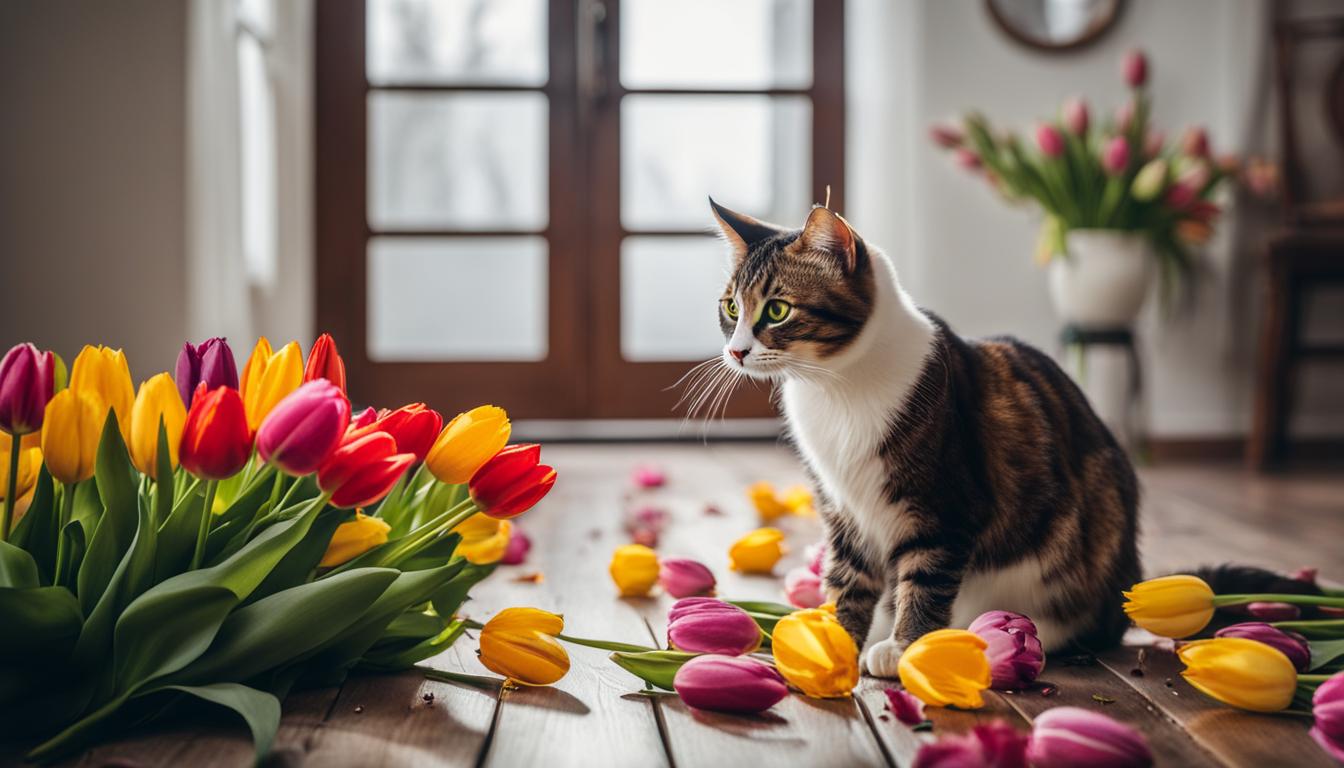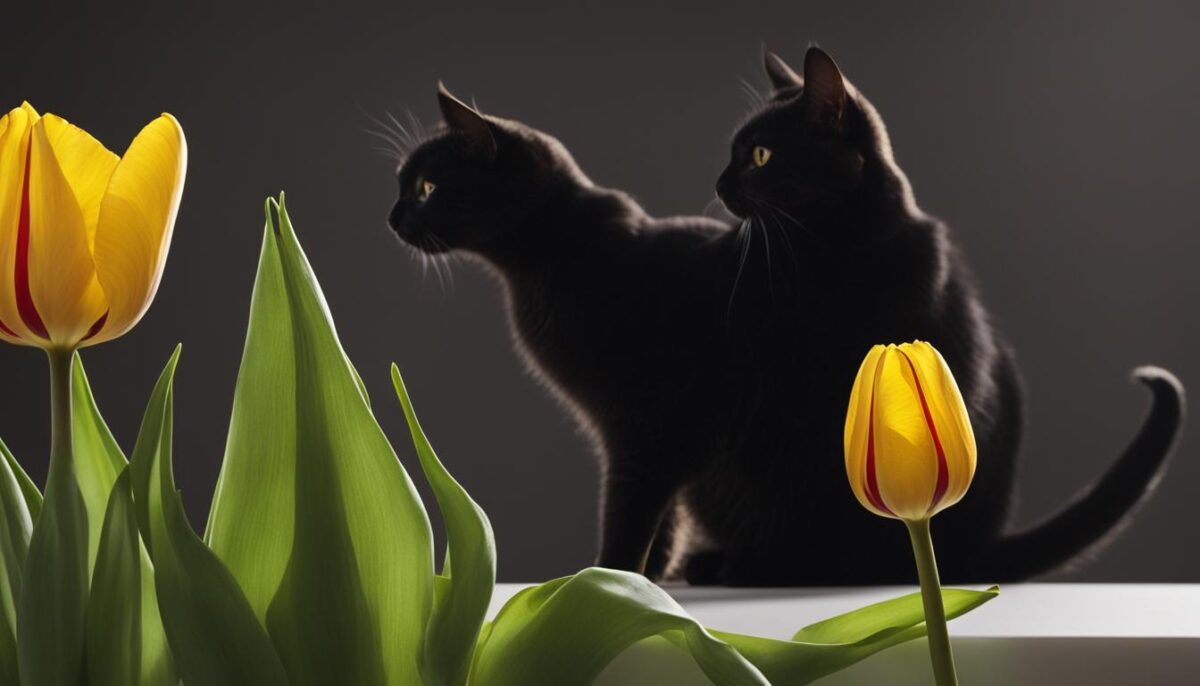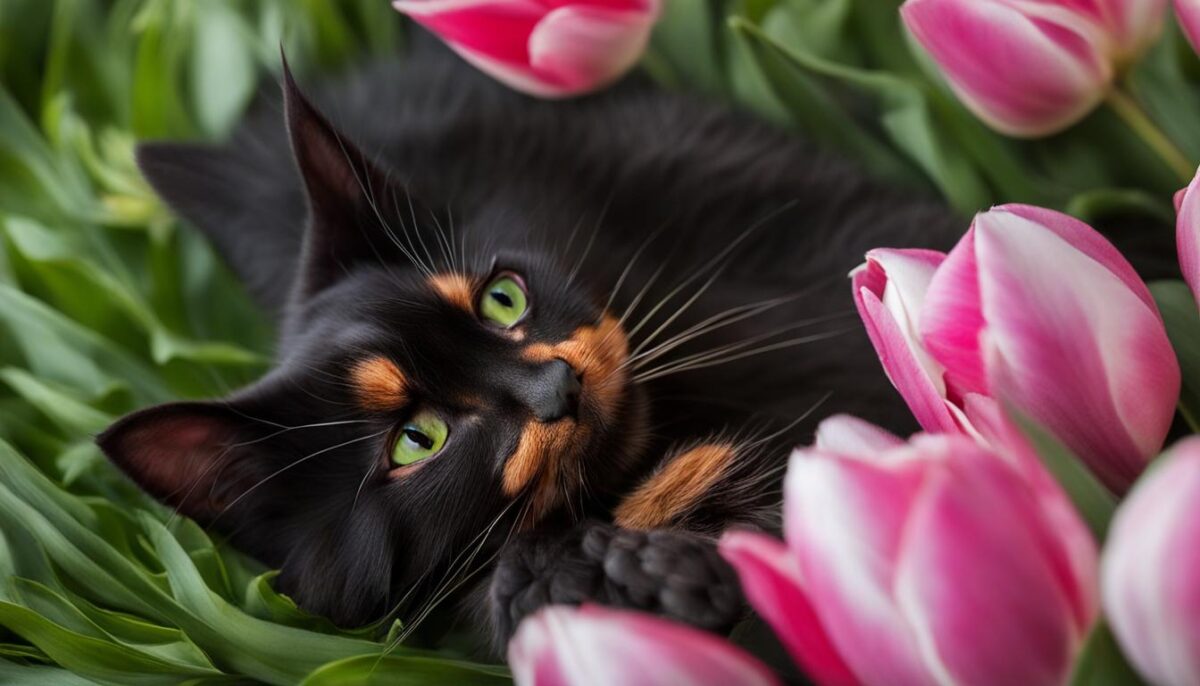As a cat owner, you want your furry friend to be happy and healthy. Did you know that those pretty flowers you love might not be safe for your cat? Tulips can harm cats, and it’s important to keep these plants away from your curious pet. Every part of the tulip plant can make your cat feel sick. If your cat nibbles on a tulip, you should call your vet right away.
You might have tulips inside your home or in your garden. Cats often like to play with plants, bite them, or eat them. This means your cat could eat parts of a tulip. It’s good to know which plants are safe and which are not. Let’s keep our cats safe by learning about tulip toxicity in cats, keeping an eye on feline health, and knowing about pet safety with cat-friendly plants.
Key Takeaways
- Tulips can hurt your cat if they eat them.
- Every part of the tulip is bad for cats.
- Call your vet fast if your cat eats a tulip.
- Keep tulips away from where your cat can get them.
- Choose cat-friendly plants to keep your pet safe.
The Hidden Danger of Tulips to Your Feline Friends
Did you know the tulips that look pretty in your yard or your home can be a big no-no for your cat? It’s true! These plants might be bad for your purring pal. If your cat chews or eats any part of a tulip, they might end up feeling very sick. And it’s mostly because of the tulip bulb – that’s the round part in the ground that the tulip grows from. It has the most stuff that can harm your cat.
So if you’ve got tulips at home, you should make sure your cat can’t get to them. You love your cat, and you don’t want them to face any feline risks. Let’s take a look at a list of plants that aren’t safe for your kitty, so you know what to keep out of reach.
- Tulips – They have toxins that can hurt your cat, especially the bulbs.
- Lilies – Super dangerous and can even cause kidney failure in kitties.
- Hyacinths – Just like tulips, not free of risks for your furry friend.
But wait, there are also good plants! Here are some that are safe for cats and won’t cause any trouble:
- Roses – They are totally fine for your cat to sniff around!
- Snapdragons – Cool flowers and safe for your cat pals.
- Marigolds – No worries with these around your kitties.
Knowing about tulip dangers and pet toxic plants helps you take care of your cat better. You want to make sure your house is a safe place for them to explore and have fun without any harmful plants for cats around.
https://www.youtube.com/watch?v=I4GKwhqjw5g
| Plant | Safe for Cats | Risks |
|---|---|---|
| Tulips | No | Bulb is highly toxic |
| Lilies | No | Can cause kidney failure |
| Hyacinths | No | Toxic components throughout |
| Snapdragons | Yes | None |
| Roses | Yes | None |
| Marigolds | Yes | None |
Now you see that keeping your cat safe from tulips and other harmful plants for cats is important. You care about your feline friend, so it’s a good idea to pick plants for your home that pose no feline risks. Happy planting, and remember to keep it safe for your pets! 😺
Understanding the Toxins in Tulips
Beautiful tulips have a secret. They hold chemicals that can be harmful to your furry friends. We see these flowers as pretty, but for cats, they can be dangerous.
Alkaloid and Glycoside Compounds in Tulips
Tulip toxins are not something to play with. Tulips have substances called glycosides and alkaloid compounds. They might sound fancy, but they’re not good news for your cat. These parts in tulips can make your kitty feel super sick if they decide to chew on them.
Allergenic Lactones and Their Effects on Cats
Besides glycosides and alkaloids, tulips also have something called allergenic lactones. That’s a big word for a nasty thing that can make cats itchy and uncomfortable. It’s really important to keep an eye on your cats to make sure they stay away from these flowers.
| Toxic Substance | Found In | Effect on Cats |
|---|---|---|
| Glycosides | Stem, Leaves, Bulbs | Upset stomach, Heart problems |
| Alkaloid Compounds | Entire Plant | Weakness, Loss of appetite |
| Allergenic Lactones | Stem, Leaves | Itchy skin, Swelling |
So, if you have these pretty tulips in your house, make sure to keep them up high where your cat can’t reach. It’s always better to be safe and help keep our cat friends healthy and happy!
Recognizing Symptoms of Tulip Poisoning in Cats
When cats get sick from eating tulips, they might throw up or feel yucky. If you see your cat drooling more than normal, having a hard time in the litter box, or just looking sad, these could be signs of tulip poisoning.
Some cats might even act really sick if they eat a lot of the flower or the bulb part. Their tummy might hurt, their body could shake, and their heart might go very, very fast. It’s scary, but they could also have trouble breathing, get seizures, or even fall into a coma. Listen for fussy sounds they make because it means they are not feeling good.
- Vomiting
- Excessive drooling
- Diarrhea
- Depression
- Abdominal pain
- Tremors
- Rapid heartbeat
- Difficulty breathing
- Seizures
- Coma
If you think your cat has eaten tulips, it’s important to call the vet right away. Keeping an eye on your cat for any odd signs can help catch toxic plants reactions quickly.
Immediate Response: What to Do If Your Cat Eats a Tulip
If your cat snacks on a tulip, you need to act fast! First, pick up the phone and get vet advice. They know lots about emergency pet care and will tell you the best steps to take. Keep calm, because that will help both you and your furry buddy.
Contacting Your Vet is Crucial
Your vet is your go-to person when your cat needs help. They have lots of knowledge about tulip ingestion in kitties and how to make them feel better. So, if those pretty tulips get chomped on, the vet is just a call away. They’re there to help with feline first aid, so trust what they tell you.
Preventing Further Ingestion and Getting Treatment
Now, make sure your cat doesn’t eat more tulips! Keep them away from any plants while you get ready to see the vet. Your vet might suggest some treatments like a special syrup to make your cat vomit or lots of water to flush things out. They care a lot about your cat and will do the right thing to help them heal.
| What Happened? | What to Do? | Who to Call? |
|---|---|---|
| Cat ate a tulip | Keep plants away from cat | Your vet for help |
| Need to act quickly | Follow the vet’s instructions | Emergency pet care centre |
| Need for treatment | Take your cat to the vet’s clinic | Professional for feline first aid |
Remember, your vet is there for you and your cat. They’re super helpful when it comes to things like treating tulip ingestion. Keep their number handy, just in case!
Proactive Measures to Protect Cats from Tulip Toxins
Keeping your cat safe from tulips starts with pet-proofing your home. Make sure to place tulips and other harmful plants out of reach. This means not only on high shelves but looking for sneaky spots where your cat might try to jump.
It’s also smart to consider cat safety measures outdoors. If you have a garden, create a special area that’s free from tulips and other toxic plants. This way, your kitty can enjoy the outdoors without any risks.
If you like to keep plants around, choose non-toxic plants. There are many beautiful flowers and plants that won’t hurt your cat. Some pet-safe options include catnip, which can actually be fun for them!
Being a responsible pet owner means knowing what’s safe for your cat to nibble on. If they like greens, give them cat grass instead of dangerous flowers.
Here’s a list of safe, non-toxic plants that you can keep in your home:
- African violet
- Spider plant
- Bamboo
- Money plant
And remember, if you’re not sure if a plant is safe, it’s best to keep it away from your cat. Or, ask someone who knows about plants, like a gardener or a vet.
Check out this table for a quick look at cat-friendly vs. unsafe plants:
| Safe for Cats | Unsafe for Cats |
|---|---|
| Catnip | Tulip |
| Spider Plant | Lily |
| Boston Fern | Oleander |
| Basil | Azalea |
With these tips, you can create a safe and happy space for your furry friend!
Conclusion
As your furry friends’ faithful friend, it’s up to you to make your space safe for them. Cats are curious, and they love to explore, so keeping plants like tulips that can make them sick away from them is important. By choosing the right flowers and greens for your home and garden, you’ll create a space where your pet can be happy and healthy.
Making Your Garden and Home Safer for Cats
To make a feline-friendly gardening space, steer clear of tulips and pick plants that are safe for cats. When you choose non-toxic gardening, you’re making sure that your four-legged companions stay out of harm’s way. It’s all about secure indoor plants and a safe play area outdoors.
Identifying Pet-Friendly Plants for a Peaceful Coexistence
Look for cat-safe flowers like roses or snapdragons to beautify your garden without worry. A peaceful coexistence with your pets is easy when you check if your plants are safe for them. Remember, every plant you bring home should be a friend to your cat.
FAQ
Are Tulips Toxic to Cats?
Yes, tulips are toxic to cats. Every part of a tulip contains compounds that can pose a threat to feline health, making them unsafe if ingested.
What Substances in Tulips are Harmful to Cats?
Tulips contain toxic substances like glycosides, alkaloid compounds, and allergenic lactones which can all contribute to tulip toxicity in cats, making them a pet toxic plant.
What are the Symptoms of Tulip Poisoning in a Cat?
Symptoms of tulip poisoning in cats can include vomiting, excessive drooling, diarrhea, lethargy, abdominal pain, tremors, increased heart rate, difficulty breathing, seizures, and potentially coma.
What Should I Do if My Cat Eats a Tulip?
If you suspect your cat has eaten any part of a tulip, contact your vet immediately for advice. It’s an emergency pet care situation that might require prompt treatment.
How Can I Prevent My Cat from Accessing Tulips?
To prevent your cat from getting to tulips, pet-proof your home and garden by removing these plants entirely or ensuring they are out of reach. Choose non-toxic plants as safer alternatives for your cat.
Are There any Cat-Friendly Plants I Can Have Instead?
Absolutely, there are many cat-safe flowers and plants you can have instead of tulips. Some examples include roses, snapdragons, and cat grass, which are non-toxic to cats and add beauty to your home and garden.
How Can I Make My Garden Safe for My Cat?
Making your garden safe for your cat involves choosing feline-friendly gardening practices like selecting non-toxic plants and ensuring all plants and garden materials are secure and safe for pets.
What Are the Long-Term Effects of Tulip Toxicity on Cats?
Depending on the severity of the tulip ingestion, long-term effects can range from mild gastrointestinal upset to more severe health issues, including potential damage to the kidneys or heart if not treated promptly.


